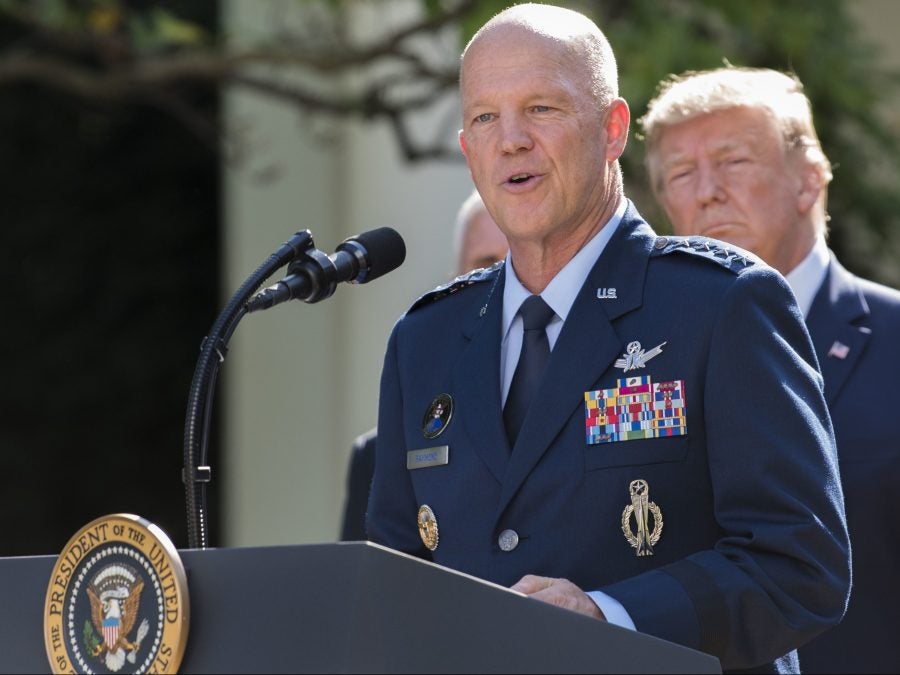
The head of the US Space Command (USSPACECOM) and US Air Force Space Command, General John Raymond, said he was ‘really eager’ for Congress to authorise the creation of a US Space Force.
The Space Force would become the sixth branch of the US Armed Forces if authorised by Congress in the upcoming National Defense Authorization Act (NDAA). The legislation, which sets the annual budget for the Department of Defense, includes a section devoted to the creation of the Space Force or ‘Space Corps’.
Speaking at the Centre for Strategic and International Studies in Washington DC, Raymond said: “I’m really eager for Congress to pass this NDAA so we can have the Space Force.” Raymond also provided more details about the possible structure of the Space Force and how it would fit in with the various combatant commands.
He said: “What we’re looking to do is elevate space and separate it from the air force, and have a singularly focused service, focused on this domain.” A US Space Force, he said, would be analogous to the US Navy command model.
In the Space Force, Raymond explained, “you’d have a Secretary of the Air Force with a Chief of Staff of the Space Force [however the law comes out] and a Chief of Staff of the Air Force”.
When asked whether the creation of US Space Command, possibly followed by a US Space Force, could be seen as an aggressive move by other countries Raymond said that the Space Command is a “warfighting command” with a mission statement that says “US Space Command will conduct offensive and defensive operations”.
How well do you really know your competitors?
Access the most comprehensive Company Profiles on the market, powered by GlobalData. Save hours of research. Gain competitive edge.

Thank you!
Your download email will arrive shortly
Not ready to buy yet? Download a free sample
We are confident about the unique quality of our Company Profiles. However, we want you to make the most beneficial decision for your business, so we offer a free sample that you can download by submitting the below form
By GlobalDataHowever, Raymond made clear that in his view the goal of the US Space Command was to deter the threat of combat extending into space, where his command’s area of operation begins. “There is no such thing as space deterrence, it is just deterrence,” he said, adding that the best way to deter conflict in space was from a position of strength.

The flag of the U.S. Space Command is unfurled at the White House. Credits: DoD photo by Lisa Ferdinando.
US Space Command’s wider goal
Elaborating on the Space Commands mission Raymond said: “Our mission set is the four Ds. First is deterrence; we do not want to get into a conflict that begins or extends into space. The second area we are focused on is to defend.
“The third D is what we’ve been really good at for years and that is to deliver. We deliver capabilities to the joint and coalition warfighter. The fourth D is to develop those joint warfighters.”
US Space Command has under its wing two separate commands, the Combined Force Space Component Command (CFSCC) and Joint Task Force Space Defense (JTF-SD). The combined element focuses on planning and integration, whereas the Joint element conducts operations.
Explaining his mission as head of both the US Space Command and Air Force Space Command, Raymond said: “Space is a warfighting domain, just like air, land and sea. You know, it used to be you couldn’t say that in public – space and warfighting in the same sentence. The US wants to keep the space domain safe.”
This fits into a wider trend across the world for an increased push into space, with NATO set to declare space an operational domain and France also planning to establish a space force.
Space Command began as a group of people in a room planning the outlines of the command and has quickly progressed over a year into a fully-fledged combatant command with around 400 personnel. The command was officially launched in August of this year.
“This is a different command, custom-built for a different day,” Raymond said. The new Space Command has a sharp focus of ‘protecting and defending’ the US military’s space-based assets, along with those of partners and allied countries, with its jurisdiction staring at 100km above the Earth’s surface.
Space Command is also pushing to integrate planning elements within other combatant commands to allow for better collaboration in a warfighting setting. Using the example of a potential conflict with Russia, Raymond said that at the outbreak of war, US European Command (EUCOM) would provide the immediate response but that modern conflict would quickly envelop other commands like Space Command, Cyber Command, and Transportation Command.
In most cases Space Command would act in a supporting role to the US other combatant commands, however, Raymond added that as technology progresses and “we’re going to have to fight for space superiority”, Space Command will likely require support from others to achieve its goal of deterring space conflict.
The makeup of Space Command will ultimately consist of a service component from the US Army, Air Force, Navy and Marine Corps. Providing a distinction between US Space Command and US Air Force Space Command, Raymond explained that the Air Force Command trains, organises, and equips personnel, whereas the US Space Command is the warfighting side.
The US in the past operated a Space Command from 1985 to 2002, but it was disbanded in a refocusing of forces after 9/11. The US is yet to decide where the US Space Command will be based. Currently, US Space Command operates from Peterson Air Force Base. Raymond said that the Secretary of the Air Force will ultimately decide where to base the command.







